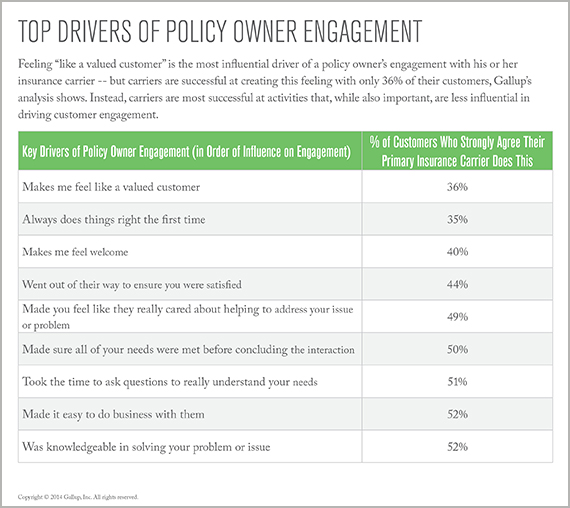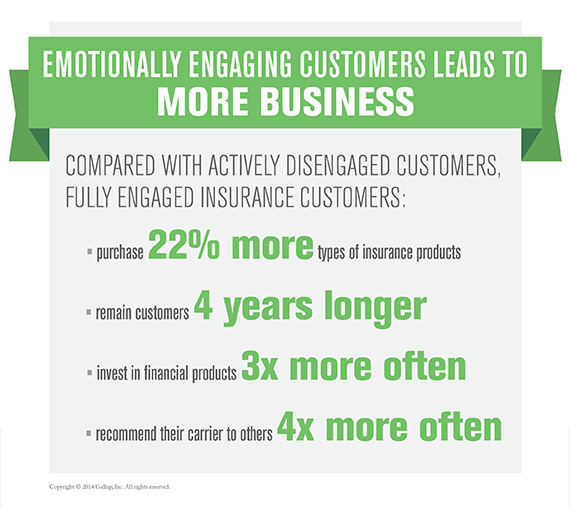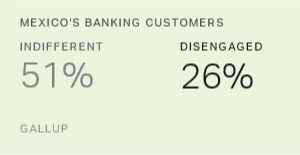Insurance companies and their agents aren't capitalizing on direct access to customers as well as they could.
Insurance companies have known for decades that a policy owner who is fully engaged is more valuable than one who is actively disengaged. What many still wonder is: What, specifically, fully engages a customer with a company's brand and products?
Gallup has spent the past 40 years helping companies understand and act on the factors that create higher levels of customer engagement and improve financial performance. Recently, Gallup studied the behaviors and preferences of more than 18,000 U.S. customers to focus on what drives their decisions about buying insurance products. Though some customers purchase insurance using online channels, most still make their original purchase from an insurance agent. Our analysis shows, however, that insurance companies and their agents aren't capitalizing on direct access to customers as well as they could.
Driving customer engagement
The most influential driver of a policy owner's engagement with his or her primary insurance carrier is feeling "like a valued customer" -- but only 36% of customers strongly agree that their carrier makes them feel valued. On the other hand, 52% of customers strongly agree that their carrier "was knowledgeable in solving [their] problem or issue" -- the least influential driver of engagement.
Why are insurance providers satisfying the weaker drivers rather than the stronger ones? It is likely because weaker drivers are easier to manage. Interactions that engage customers inspire emotions -- such as feeling valued, welcomed, and cared about -- which can be complex and elusive. On the other hand, tangible activities that require going through a set of steps -- such as walking customers through product descriptions or asking scripted questions -- may be easier than creating a genuine emotional connection with customers. Carriers that focus on activities that engage customers during every encounter are more likely to achieve higher performance versus those who do not.

The ROI
Based on decades of extensive research and consulting experience, Gallup developed its Customer Engagement Score (CES) metric. Gallup classifies customers as fully engaged, indifferent, or actively disengaged based on their responses to the CES items.
For insurance companies and their agents, emotionally engaging policy owners leads to more business. For example, compared with actively disengaged customers, fully engaged customers:
- purchase 22% more types of insurance products with their primary carrier
- remain customers four years longer
- sign up for financial products, such as investments or retirement planning, three times more often
- are almost four times as likely to recommend their insurance provider to others
However, only 34% of the customers Gallup studied are fully engaged with their insurance carrier or agent. Clearly, there's an opportunity for insurance companies and agents to increase their business with their current customers by developing stronger relationships -- and emotional connections -- with them.
What insurance carriers and their agents need to do
Here are four recommendations that insurance carriers and agents can follow to engage their policy owners more effectively:
- Have high-value conversations more frequently. Gallup's analysis shows that customers value meaningful conversations with their agents: 20% of customers who have never heard from their agent about their policies after signing a contract are fully engaged, while 41% are actively disengaged. In contrast, 38% of customers whose agent has contacted them about their policies in the past 12 months are fully engaged, while only 17% are actively disengaged. But this doesn't mean agents should call just to "check in." Insurance customers are highly price-sensitive, and with nothing else to discuss, customers may default to talking about price. So agents should do more than just talk with customers about how they can save money on their current policy. They could call to wish customers well on a birthday, anniversary, or graduation. They could send a check instead of directly depositing funds, then call to confirm that the customer received the check. Conversations like these are more likely to create engagement by making policy owners feel like their insurance provider's agents genuinely value them.
- Improve responsiveness. Only 35% of customers strongly agree that their primary carrier always does things right the first time -- but this is the second most powerful driver of customer engagement. Insurance providers and agents should be aware of the importance of getting things right the first time and hold themselves accountable to their customers' standard by ensuring that they understand and meet customer needs on the first call.
- Equip agents with an effective single source for content and information. Agents must have access to the resources they need to get things right the first time. They should have one source for the information they need rather than having to make multiple calls to solve customers' problems or answer their questions. Carriers should also establish knowledge generalists at the home office to support agents if these resources aren't currently available and ensure that agents know how to access them quickly. An effective way to achieve this level of agent support is consolidating resources into one center of expertise for all products, insurance, and investments.
- Evaluate customer perceptions of value-added services, and adjust to create greater impact and differentiation. Every insurance company offers an array of value-added services such as risk assessments, identity theft protection, and emergency travel services. But do customers agree that those services actually add value? For these offerings to be effective at creating customer engagement, carriers must know which offerings trigger the greatest emotional connection between them and their policy owners. Gallup's analysis shows that most customers don't feel that their carrier values them, and the right value-added services could correct this. Carriers need to know which offerings will truly differentiate them from their competitors, then adjust the positioning of each offering to attract and engage customers by ensuring agents know how to present the offerings to customers.
Right now, only about one-third of insurance customers are engaged. That means the insurance industry has an enormous opportunity to increase business with its current customers by developing stronger emotional connections with them. By helping agents understand the value of engagement and teaching them how to engage customers, the industry can begin capitalizing on profits that have been lost to disengagement.
Survey Methods
Results are based on a Gallup Panel Web and mail study completed by 18,039 national adults, aged 18 and older, conducted December 4, 2013, to January 14, 2014. The Gallup Panel is a probability-based longitudinal panel of U.S. adults who are selected using random-digit-dial (RDD) phone interviews that cover landline and cellphones. Address-based sampling methods are also used to recruit panel members. The Gallup Panel is not an opt-in panel, and members are not given incentives for participating. The sample for this study was weighted to be demographically representative of the U.S. adult population using 2012 Current Population Survey figures. For results based on this sample, one can say that the maximum margin of sampling error is +/- 1 percentage points, at the 95% confidence level. Margins of error are higher for subsamples. In addition to sampling error, question wording and practical difficulties in conducting surveys can introduce error and bias into the findings of public opinion polls.
